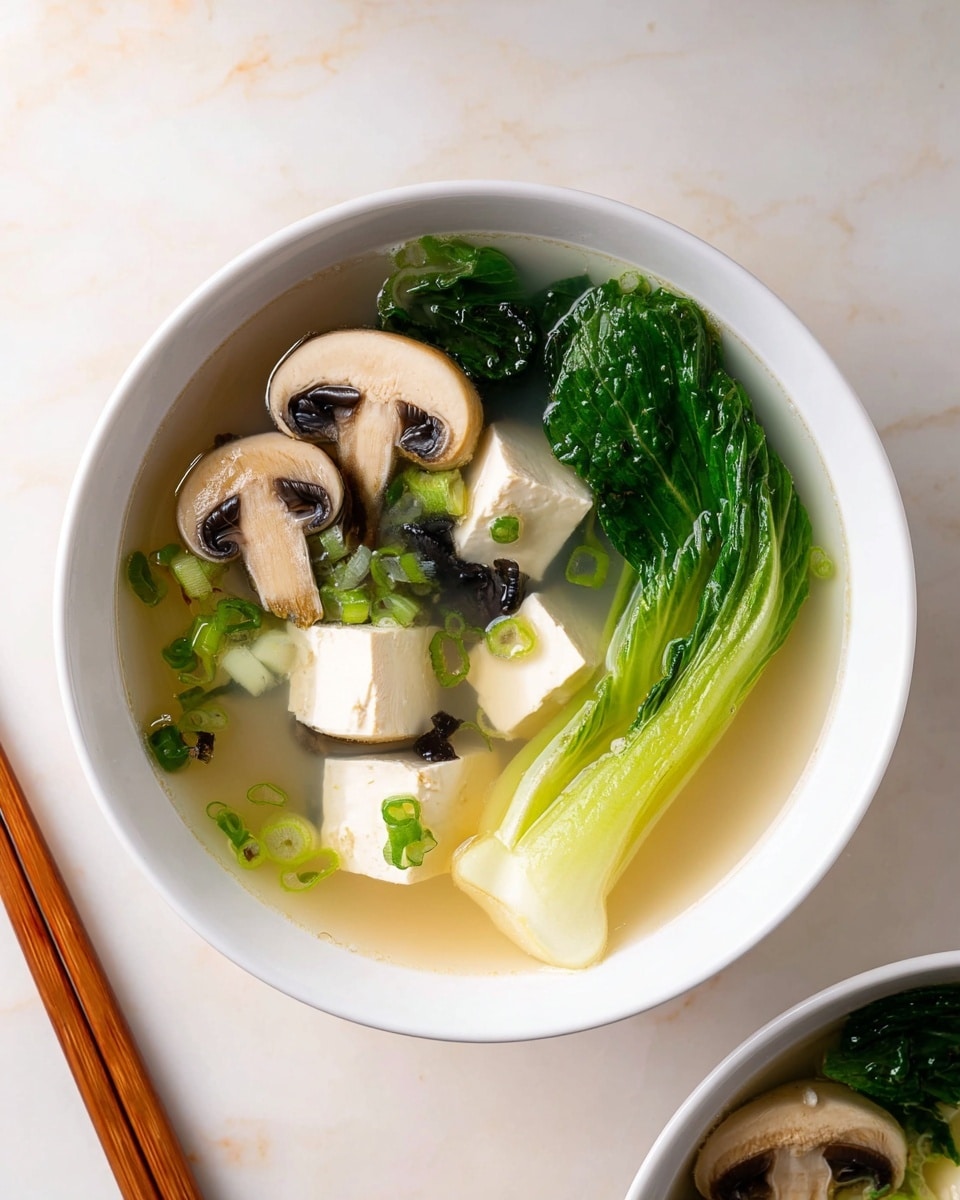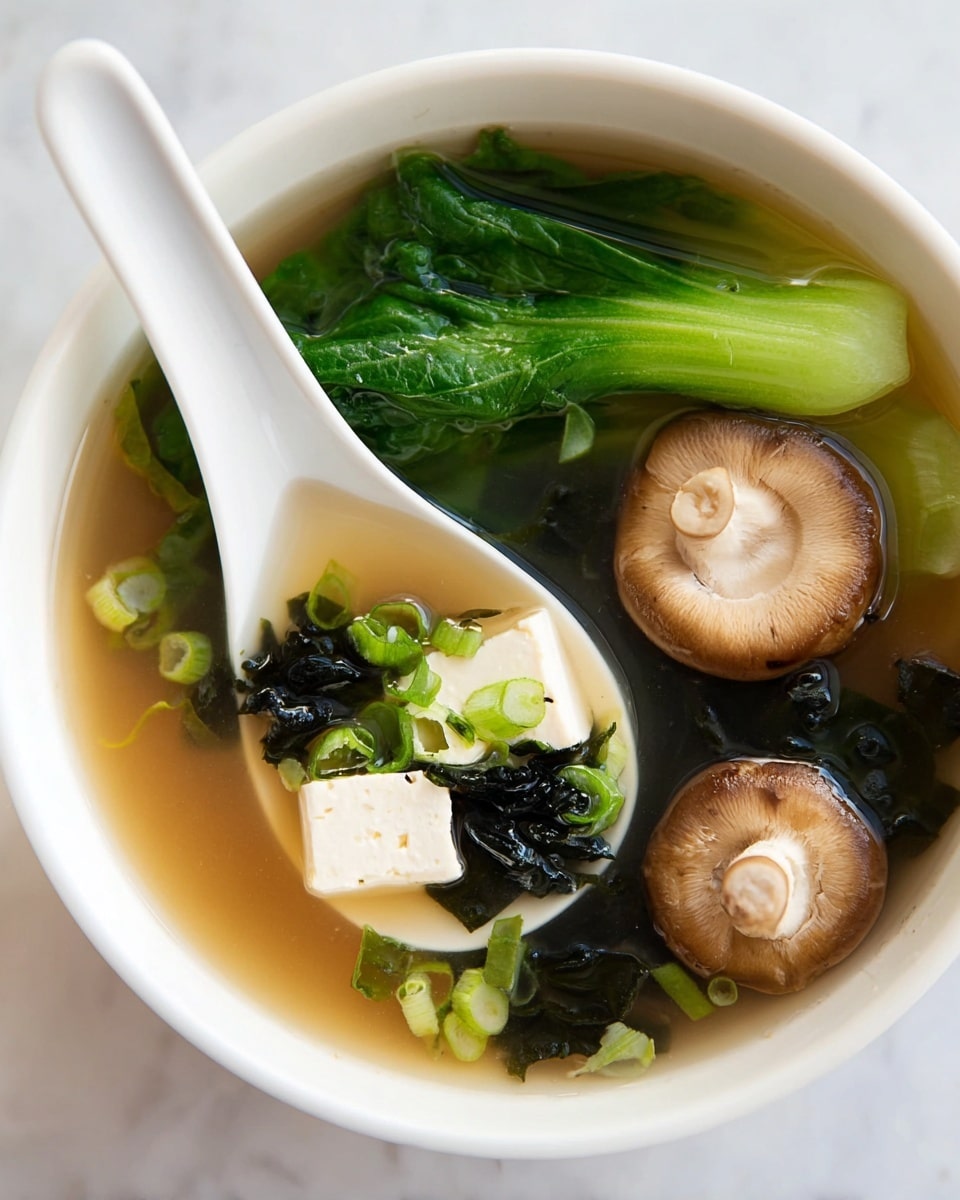Gluten-Free Miso Soup Recipe

I’m excited to share this cozy, comforting Gluten-Free Miso Soup Recipe with you—it’s one of those dishes that’s simple, soothing, and packed with umami flavor. Whether you’re new to miso soup or a seasoned fan, this recipe works wonders as a quick lunch, a light dinner, or a perfect starter when hosting friends. I especially love how it comes together fast with pantry staples while still feeling special and nourishing.
What makes this Gluten-Free Miso Soup Recipe stand out is how easy it is to adjust according to what you have on hand, yet it never loses its comforting, savory depth. Plus, it’s naturally gluten-free when you use the right dashi and miso, so it’s great if you’re cooking for someone with gluten sensitivities or just looking to lighten up your meal. I find it’s a real kitchen MVP during chilly evenings or when I want something warm and gentle on the stomach.
Ingredients You’ll Need
All these ingredients work beautifully together to create a broth that’s earthy, salty, and rich with a subtle sweetness from the tofu and greens. When shopping, look for certified gluten-free dashi and miso to keep it safe, and fresh mushrooms really elevate the texture and flavor.
- Water: The base of your broth—clean, fresh water helps delicate flavors shine.
- Gluten-free dashi powder: This is your umami bomb! Check labels for gluten-free certification.
- Mushrooms (Oyster, Enoki, or Shiitake): I love Shiitake for its deep flavor but any works; fresh mushrooms give the soup a meaty texture.
- White miso paste: The soul of the soup—white miso is mild and slightly sweet, perfect for a gentle broth.
- Firm silken tofu, cut into 1” squares: Adds creaminess and protein without overpowering the flavors.
- Wakame seaweed (Nori also works): This brings a subtle oceanic note that’s classic and nourishing.
- Baby bok choy: Adds fresh crunch and lovely green color—one of my favorite greens for this soup.
- Sesame oil: For drizzling at the end—adds a toasty aroma and richness that finishes the soup beautifully.
Variations
One of the reasons I keep coming back to this Gluten-Free Miso Soup Recipe is how flexible it is—you can easily make it your own. I often tweak it based on what veggies or mushrooms I have in the fridge, or how hearty I want it to be.
- Add shredded carrots or daikon radish: I tried adding these for a crunchy texture and sweet earthiness that brightened the soup on a cold winter day.
- Swap the tofu for cooked chicken or shrimp: If you want to make it more filling, this is a personal favorite for a cozy meal with extra protein.
- Use kombu powder instead of dashi powder: For an even deeper seaweed flavor using a natural, whole food ingredient.
- Switch baby bok choy for spinach or kale: I do this depending on the season and what greens are freshest.
- Spice it up with a dash of chili oil or sliced jalapeños: When I’m craving a little heat, it adds a fun twist while keeping it gluten-free.
How to Make Gluten-Free Miso Soup Recipe
Step 1: Prepare Your Broth Base
Start by bringing 6 cups of water to a gentle simmer in a medium pot. Sprinkle in 1 tablespoon of gluten-free dashi powder and stir to dissolve fully—that’s the secret to that rich umami flavor that miso soup thrives on. Make sure not to boil vigorously here because too much heat can affect the delicate flavors downstream.
Step 2: Add Mushrooms and Greens
While the dashi simmers gently, clean and slice about 6 ounces of mushrooms—you can pick oyster, enoki, or shiitake depending on your mood. Add them to the pot along with 1 bunch of baby bok choy broken into bite-sized pieces. Let these simmer for about 5 minutes until the mushrooms are tender and the greens wilt slightly.
Step 3: Gently Incorporate the Miso Paste
This is key: Remove about a cup of the hot broth into a small bowl and whisk in 3 to 4 tablespoons of white miso paste until smooth. Then slowly stir this miso mixture back into the pot off the heat—avoid boiling once miso is added to preserve its complex flavors and probiotics. This little trick always makes my soup taste bright and fresh instead of dull or bitter.
Step 4: Add Tofu and Seaweed
Now toss in 1 cup of firm silken tofu cut into 1-inch squares along with 2 tablespoons of wakame seaweed or nori strips. Let the soup warm through gently for another minute or so—just enough to heat the tofu without breaking it apart. At this stage, the flavors start to meld and the texture gets wonderful.
How to Serve Gluten-Free Miso Soup Recipe

Garnishes
I love to finish this soup with a small drizzle of toasty sesame oil right before serving; it adds a warm, nutty aroma that’s just irresistible. Sometimes I sprinkle a bit of finely sliced green onions or toasted sesame seeds if I want it extra pretty and flavorful. These simple garnishes really bring the soup to life and add that final savory lift.
Side Dishes
This soup pairs beautifully with a crisp cucumber salad or steamed jasmine rice for a soothing, rounded meal. When I’m feeling fancy, I serve it alongside gluten-free tempura vegetables or a sushi platter for a restaurant-style experience at home. It’s also great for breakfast if you enjoy savory starts!
Creative Ways to Present
For special occasions, I’ve served this soup in pretty ceramic bowls with delicate bamboo ladles—simple touches that make a big difference. You could also portion it into small cups as an elegant appetizer or add edible flowers for a pop of color. I like trying different presentations to make everyday meals feel like celebrations.
Make Ahead and Storage
Storing Leftovers
I usually store leftover miso soup in an airtight container in the fridge for up to 2 days. Pro tip: Keep the miso mixture separate if you want the soup to last longer or taste fresher, adding it just before reheating. That way you preserve the delicate flavors and beneficial probiotics in the miso.
Freezing
Freezing isn’t my favorite option for this soup because miso’s flavor and texture can change, and tofu might get grainy after thawing. But if you need to, freeze without the tofu and miso paste, then add those fresh after thawing and warming up the broth. It’s a little extra step but helps keep the soup tasting its best.
Reheating
When reheating, warm the soup gently on the stove over low heat, stirring occasionally. Avoid boiling, especially after adding miso, so you don’t lose that subtle complexity and the soup doesn’t become bitter. I find low and slow is the trick to keeping it tasting like I just made it.
FAQs
-
Can I use regular miso paste instead of gluten-free?
You can use regular miso paste, but if you’re aiming for a truly gluten-free miso soup, make sure the miso you buy specifically states it’s gluten-free, as some contain barley or wheat. Using certified gluten-free miso ensures no hidden gluten sneaks in, which is especially important if you’re cooking for those with celiac or gluten intolerance.
-
What’s the best way to store leftover miso soup?
Store leftovers in an airtight container in the refrigerator and consume within 2 days. To keep the flavor fresh, I recommend storing the miso paste separately and adding it right before reheating. This keeps the delicate flavors and probiotics in the miso intact.
-
Can I make this soup vegan?
Absolutely! This Gluten-Free Miso Soup Recipe is naturally vegan when you use vegetable-based dashi powder instead of fish-based options. Just double-check your dashi and miso labels to ensure they fit your diet.
-
Is it okay to boil the soup after adding miso paste?
It’s best not to boil the soup after adding miso paste, as high heat can kill the beneficial bacteria in miso and make the flavor bitter. Instead, stir miso into a small amount of hot broth off the heat, then combine everything gently to preserve the taste and health benefits.
-
What can I use instead of wakame seaweed?
Nori sheets work as a great substitute for wakame seaweed if you don’t have it. Simply tear nori into small strips and add them toward the end of cooking. The flavor will be a bit different but still lovely and ocean-inspired.
Final Thoughts
This Gluten-Free Miso Soup Recipe feels like a warm hug in a bowl every time I make it. It’s an easy recipe that brings together simple ingredients into something delightfully flavorful and nourishing. I really encourage you to try it out and tweak it to your taste—you might find it becoming one of your go-to comfort foods just like it is for me. Trust me, once you get the hang of managing the heat with miso and dashi, this soup will become your kitchen secret weapon.
PrintGluten-Free Miso Soup Recipe
This Gluten-Free Miso Soup is a comforting and nourishing Japanese-inspired broth made with gluten-free dashi, a medley of fresh mushrooms, tender baby bok choy, and silken tofu. Enhanced with nutrient-rich wakame seaweed and a delicate drizzle of sesame oil, this soup is perfect for a light meal or an appetizer that is both flavorful and easy to prepare.
- Prep Time: 10 minutes
- Cook Time: 15 minutes
- Total Time: 25 minutes
- Yield: 4 servings 1x
- Category: Soup
- Method: Stovetop
- Cuisine: Japanese
- Diet: Gluten Free
Ingredients
Broth and Base
- 6 cups water
- 1 tbsp gluten-free Dashi powder
Vegetables and Proteins
- 6 oz mushrooms (Oyster, Enoki, or Shiitake)
- 1 bunch baby bok choy
- 1 cup firm silken tofu, cut into 1” squares
- 2 tbsps wakame seaweed (Nori can also be used)
Condiments
- 3–4 tbsps white miso paste
- Sesame oil, for drizzling
Instructions
- Prepare the Dashi Broth: In a medium pot, bring 6 cups of water to a gentle simmer. Sprinkle in 1 tablespoon of gluten-free Dashi powder and stir until fully dissolved to create a flavorful broth base.
- Add the Mushrooms and Bok Choy: Clean and slice the mushrooms if needed. Add the 6 oz of mushrooms and the whole baby bok choy to the simmering broth. Cook for about 5 minutes until the mushrooms are tender and bok choy is slightly wilted.
- Incorporate Wakame Seaweed: Add 2 tablespoons of wakame seaweed (pre-soaked if dried) into the broth. Let it hydrate and soften for about 2-3 minutes, stirring gently.
- Add the Tofu: Carefully add 1 cup of firm silken tofu cut into 1-inch squares to the pot. Simmer gently for another 3-4 minutes to warm the tofu without breaking it apart.
- Mix in the Miso Paste: In a small bowl, ladle a cup of warm broth and whisk in 3 to 4 tablespoons of white miso paste until fully dissolved. Pour this miso mixture back into the pot, stirring gently to combine. Avoid boiling the soup after adding miso to preserve its delicate flavors and beneficial probiotics.
- Finish and Serve: Turn off the heat and drizzle a small amount of sesame oil over the soup for added aroma and richness. Ladle into bowls and serve hot.
Notes
- Do not boil the soup after adding miso paste to preserve its nutrients and flavor.
- Soak dried wakame seaweed in water for 5 minutes before adding if using dried form.
- You can substitute baby bok choy with spinach or other leafy greens if preferred.
- This soup is naturally gluten-free but always double-check ingredient labels if you have severe gluten intolerance.
Keywords: gluten-free, miso soup, Japanese soup, tofu soup, healthy soup, plant-based, seafood-free, quick soup







